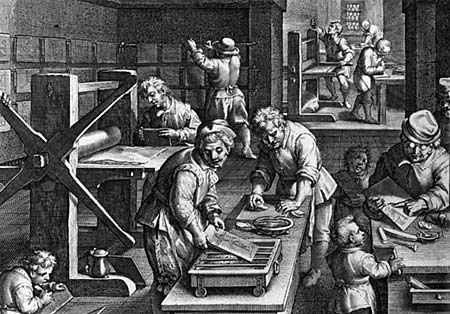History of Printing
The key figure in the history of printing is Johann Gutenberg (1400? - 1468) of Mainz, Germany. He was a silversmith by profession. Around 1430-40 he invented movable, interchangeable, re-usable type, for printing on a wooden press (adopted from wine or cheese Gutenbergusing a printing ink of a composition invented by him. It was an oily, varnish-like ink made of soot, turpentine, and walnut oil.
His business was backed by a man called Fust (or Faust) and he had an assistant Peter Schöffer - the print shop probably had around 25 staff and aimed to print around six pages of a book per day. His masterpiece is the Bible printed in 1453-4 , 180 copies were made, each of 1282 pages with 42 lines in two columns. They were designed to be completed by colouring main capitals etc by hand. 48 copies are known to exist now ( a very fine copy is held in the John Rylands Library in Manchester).
Gutenberg’s actual technique of making movable type remains unclear; he was familiar with the craft of casting metal from a reverse impression. He may have made castings from sand or plaster, but we probably shall never know for certain. However we know that a few years after his death the process used involved the production of a metal punch, the end of which would have been cut to produce a reverse impression of the type.
During the seventeenth century The Netherlands became the centre of book printing for most of Europe; the foremost printer was Christophe Plantin who by 1576 was running twenty-two presses.
